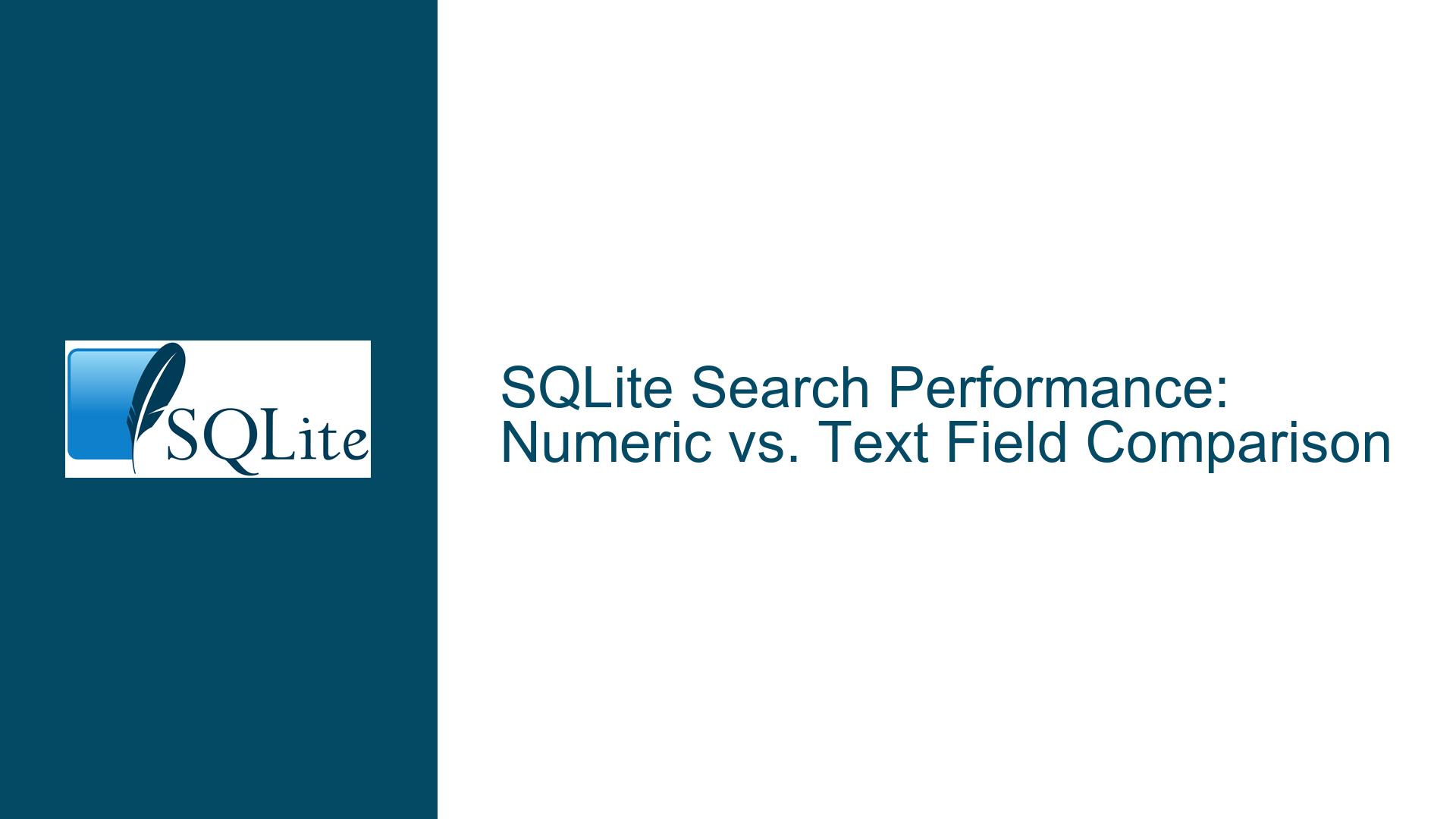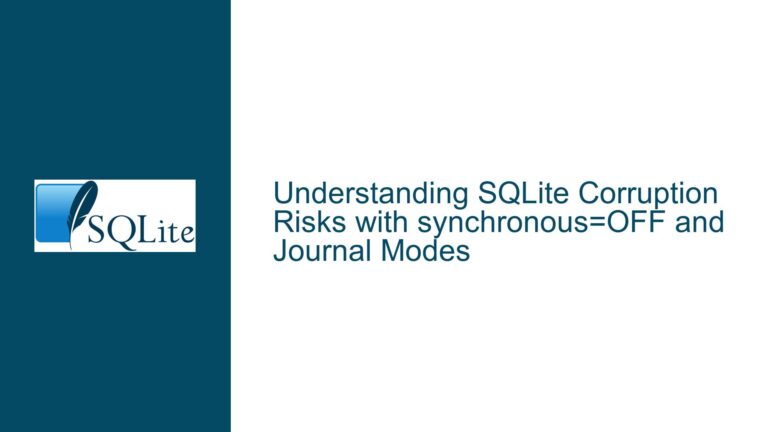SQLite Search Performance: Numeric vs. Text Field Comparison
Impact of Field Type on SQLite Search Performance
When designing a database schema in SQLite, one of the critical decisions is choosing the appropriate data type for each field. This decision can have a significant impact on the performance of search operations, especially when dealing with large datasets. In this analysis, we will explore the performance implications of using a numeric field (specifically, an 8-byte signed integer) versus a fixed-length 128-character text field for search operations. We will assume that the table size remains constant in both scenarios and that neither field is a primary key.
The primary concern here is how the choice of data type affects the efficiency of search operations. Numeric fields, such as integers, are generally more efficient for search operations due to their smaller size and simpler comparison logic. On the other hand, text fields, especially those with a fixed length of 128 characters, require more storage space and more complex comparison logic, which can lead to slower search performance.
To understand the performance impact, we need to consider several factors, including the size of the data, the structure of the index, and the underlying mechanisms of SQLite’s search algorithms. The size of the data directly affects the amount of I/O operations required to read and compare the data. A larger data size means more bytes need to be read from disk or memory, which can slow down the search process. Additionally, the structure of the index plays a crucial role in determining the efficiency of search operations. A well-structured index can significantly reduce the number of comparisons needed to locate a specific record, but the size of the index itself can also impact performance.
In the case of a numeric field, the index will be smaller and more compact, allowing for faster traversal and fewer cache misses. In contrast, a text field index will be larger and more complex, potentially leading to slower search times due to increased I/O and cache misses. The depth and breadth of the index also play a role in determining search performance. A deeper index requires more levels of traversal, while a broader index allows for more keys to be stored on each page, reducing the number of pages that need to be accessed.
Interrupted Write Operations Leading to Index Corruption
One of the potential causes of performance degradation in SQLite search operations is index corruption, which can occur due to interrupted write operations. When a write operation is interrupted, such as during a power failure or system crash, the index may become corrupted, leading to slower search performance or even incorrect search results. This is particularly relevant when dealing with large text fields, as the larger size of the index increases the likelihood of corruption.
Index corruption can manifest in several ways, including missing or duplicate entries, incorrect pointers, or fragmented index pages. When the index is corrupted, SQLite may need to perform additional checks and repairs during search operations, which can significantly slow down the search process. In some cases, the database may become inaccessible until the index is repaired.
To mitigate the risk of index corruption, it is essential to implement proper database maintenance practices, such as regular backups and integrity checks. Additionally, using a robust journaling mode, such as WAL (Write-Ahead Logging), can help prevent index corruption by ensuring that changes are written to a log file before being applied to the database. This allows the database to recover more quickly from interruptions and reduces the risk of corruption.
Another factor to consider is the impact of index depth and breadth on search performance. As mentioned earlier, a deeper index requires more levels of traversal, which can slow down search operations. However, the depth of the index is not solely determined by the size of the data; it also depends on the fan-out of the index. Fan-out refers to the number of keys that can be stored on each index page. A higher fan-out means that more keys can be stored on each page, reducing the number of pages that need to be accessed during a search.
In the case of a numeric field, the fan-out will be higher due to the smaller size of the keys, allowing for more efficient traversal of the index. In contrast, a text field index will have a lower fan-out, resulting in a deeper index and slower search performance. The difference in fan-out between numeric and text fields can be significant, with numeric fields typically having a fan-out that is 11 times higher than that of text fields. This difference in fan-out can lead to a four-fold increase in index depth for text fields, further exacerbating the performance gap.
Implementing PRAGMA journal_mode and Database Backup
To address the performance issues associated with search operations on text fields, it is essential to implement best practices for database maintenance and optimization. One of the most effective strategies is to use the PRAGMA journal_mode command to configure the journaling mode of the database. The journaling mode determines how SQLite handles transactions and ensures data integrity in the event of a crash or power failure.
The default journaling mode in SQLite is DELETE, which creates a separate rollback journal file for each transaction. While this mode provides a high level of data integrity, it can also lead to performance overhead, especially when dealing with large text fields. A more efficient journaling mode is WAL (Write-Ahead Logging), which writes changes to a log file before applying them to the database. This allows for faster recovery from interruptions and reduces the risk of index corruption.
To enable WAL mode, you can use the following command:
PRAGMA journal_mode=WAL;
In addition to configuring the journaling mode, it is also important to implement regular database backups to protect against data loss and corruption. Backups can be performed using the SQLite Online Backup API, which allows you to create a copy of the database while it is still in use. This ensures that the backup is consistent and up-to-date, even if the database is being actively modified.
Another strategy for improving search performance is to optimize the structure of the index. For text fields, consider using a prefix index, which indexes only the first few characters of the text. This can significantly reduce the size of the index and improve search performance, especially when dealing with long text fields. However, it is important to balance the size of the prefix with the need for accurate search results, as a shorter prefix may lead to more false positives.
Finally, consider using a combination of numeric and text fields to optimize search performance. For example, you could use a numeric field as a primary key and a text field for additional information. This allows you to take advantage of the efficiency of numeric fields for search operations while still storing the necessary text data. Additionally, you can use composite indexes that include both numeric and text fields to further optimize search performance.
In conclusion, the choice of data type for search operations in SQLite can have a significant impact on performance. Numeric fields generally offer faster search performance due to their smaller size and simpler comparison logic, while text fields can lead to slower search times due to increased I/O and cache misses. By implementing best practices for database maintenance and optimization, such as using WAL mode, regular backups, and optimized index structures, you can mitigate the performance issues associated with text fields and ensure efficient search operations in your SQLite database.






